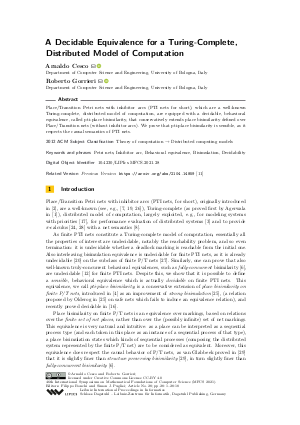A Decidable Equivalence for a Turing-Complete, Distributed Model of Computation
Authors
Arnaldo Cesco  ,
Roberto Gorrieri
,
Roberto Gorrieri 
-
Part of:
Volume:
46th International Symposium on Mathematical Foundations of Computer Science (MFCS 2021)
Part of: Series: Leibniz International Proceedings in Informatics (LIPIcs)
Part of: Conference: Mathematical Foundations of Computer Science (MFCS) - License:
 Creative Commons Attribution 4.0 International license
Creative Commons Attribution 4.0 International license
- Publication Date: 2021-08-18
File

PDF
LIPIcs.MFCS.2021.28.pdf
- Filesize: 0.7 MB
- 18 pages
Document Identifiers
Related Versions
- Previous Version https://arxiv.org/abs/2104.14859
Subject Classification
ACM Subject Classification
- Theory of computation → Distributed computing models
Keywords
- Petri nets
- Inhibitor arc
- Behavioral equivalence
- Bisimulation
- Decidability
Metrics
- Access Statistics
-
Total Accesses (updated on a weekly basis)
0Document
0Metadata
Abstract
Place/Transition Petri nets with inhibitor arcs (PTI nets for short), which are a well-known Turing-complete, distributed model of computation, are equipped with a decidable, behavioral equivalence, called pti-place bisimilarity, that conservatively extends place bisimilarity defined over Place/Transition nets (without inhibitor arcs). We prove that pti-place bisimilarity is sensible, as it respects the causal semantics of PTI nets.
Cite As Get BibTex
Arnaldo Cesco and Roberto Gorrieri. A Decidable Equivalence for a Turing-Complete, Distributed Model of Computation. In 46th International Symposium on Mathematical Foundations of Computer Science (MFCS 2021). Leibniz International Proceedings in Informatics (LIPIcs), Volume 202, pp. 28:1-28:18, Schloss Dagstuhl – Leibniz-Zentrum für Informatik (2021)
https://doi.org/10.4230/LIPIcs.MFCS.2021.28
BibTex
@InProceedings{cesco_et_al:LIPIcs.MFCS.2021.28,
author = {Cesco, Arnaldo and Gorrieri, Roberto},
title = {{A Decidable Equivalence for a Turing-Complete, Distributed Model of Computation}},
booktitle = {46th International Symposium on Mathematical Foundations of Computer Science (MFCS 2021)},
pages = {28:1--28:18},
series = {Leibniz International Proceedings in Informatics (LIPIcs)},
ISBN = {978-3-95977-201-3},
ISSN = {1868-8969},
year = {2021},
volume = {202},
editor = {Bonchi, Filippo and Puglisi, Simon J.},
publisher = {Schloss Dagstuhl -- Leibniz-Zentrum f{\"u}r Informatik},
address = {Dagstuhl, Germany},
URL = {https://drops.dagstuhl.de/entities/document/10.4230/LIPIcs.MFCS.2021.28},
URN = {urn:nbn:de:0030-drops-144686},
doi = {10.4230/LIPIcs.MFCS.2021.28},
annote = {Keywords: Petri nets, Inhibitor arc, Behavioral equivalence, Bisimulation, Decidability}
}
Author Details
References
- Tilak Agerwala. A complete model for representing the coordination of asynchronous processes. Technical report, 1974. URL: https://doi.org/10.2172/4242290.
- Tilak Agerwala and Mike Flynn. Comments on capabilities, limitations and “correctness” of petri nets. SIGARCH Computer Architecture News, 2(4):81–86, 1973. URL: https://doi.org/10.1145/633642.803973.
- Marco Ajmone, Gianfranco Balbo, Gianni Conte, Susanna Donatelli, and Giuliana Franceschinis. Modelling with generalized stochastic petri nets. SIGMETRICS Performance Evaluation Review, 26(2):2, 1998. URL: https://doi.org/10.1145/288197.581193.
- Cyril Autant, Z. Belmesk, and Philippe Schnoebelen. Strong bisimilarity on nets revisited. In PARLE '91 Parallel Architectures and Languages Europe, volume 506 of Lecture Notes in Computer Science, pages 295-312. Springer, 1991. URL: https://doi.org/10.1007/3-540-54152-7_71.
- Massimo Bartoletti, Tiziana Cimoli, and G. Michele Pinna. Lending petri nets. Science of Computer Programming, 112:75-101, 2015. URL: https://doi.org/10.1016/j.scico.2015.05.006.
- Eike Best, Raymond R. Devillers, Astrid Kiehn, and Lucia Pomello. Concurrent bisimulations in petri nets. Acta Informatica, 28(3):231-264, 1991. URL: https://doi.org/10.1007/BF01178506.
- Nadia Busi. Analysis issues in petri nets with inhibitor arcs. Theoretical Computer Science, 275(1):127-177, 2002. URL: https://doi.org/10.1016/S0304-3975(01)00127-X.
- Nadia Busi and Roberto Gorrieri. Distributed semantics for the π-calculus based on petri nets with inhibitor arcs. The Journal of Logic and Algebraic Programming, 78(3):138-162, 2009. URL: https://doi.org/10.1016/j.jlap.2008.08.002.
- Nadia Busi and G. Michele Pinna. Process semantics for place/transition nets with inhibitor and read arcs. Fundamenta Informaticae, 40:165-197, 1999. URL: https://doi.org/10.3233/FI-1999-402304.
- Nadia Busi and G. Michele Pinna. Comparing truly concurrent semantics for contextual place/transition nets. Fundamenta Informaticae, 44(3):209-244, 2000. URL: https://doi.org/10.5555/2376335.2376336.
- Arnaldo Cesco and Roberto Gorrieri. A decidable equivalence for a turing-complete, distributed model of computation, 2021. URL: http://arxiv.org/abs/2104.14859.
- Javier Esparza. Decidability and complexity of Petri net problems - An introduction, volume 1491 of Lecture Notes in Computer Science, pages 374-428. Springer Berlin Heidelberg, 1998. URL: https://doi.org/10.1007/3-540-65306-6_20.
- Ursula Goltz and Wolfgang Reisig. The non-sequential behaviour of petri nets. Information and Control, 57(2):125-147, 1983. URL: https://doi.org/10.1016/S0019-9958(83)80040-0.
- Roberto Gorrieri. Team bisimilarity, and its associated modal logic, for bpp nets. Acta Informatica, 2020. URL: https://doi.org/10.1007/s00236-020-00377-4.
- Roberto Gorrieri. Causal semantics for BPP nets with silent moves. Fundamenta Informaticae, 180(3):179-249, 2021. URL: https://doi.org/10.3233/FI-2021-2039.
- Roberto Gorrieri. Place bisimilarity is decidable, indeed!, 2021. URL: http://arxiv.org/abs/2104.01392.
- M. Hack. Petri net languages. Technical report, MIT, 1976. URL: https://doi.org/10.5555/888947.
- John E. Hopcroft and Richard M. Karp. An n^5/2 algorithm for maximum matchings in bipartite graphs. SIAM Journal on Computing,, 2(4):225-231, 1973. URL: https://doi.org/10.1137/0202019.
- Ryszard Janicki and Maciej Koutny. Semantics of inhibitor nets. Information and Computation, 123(1):1-16, 1995. URL: https://doi.org/10.1006/inco.1995.1153.
- Petr Jančar. Undecidability of bisimilarity for petri nets and some related problems. Theoretical Computer Science, 148(2):281-301, 1995. URL: https://doi.org/10.1016/0304-3975(95)00037-W.
- Ivan Lanese, Jorge A. Pérez, Davide Sangiorgi, and Alan Schmitt. On the expressiveness and decidability of higher-order process calculi. Information and Computation, 209(2):198-226, 2011. URL: https://doi.org/10.1016/j.ic.2010.10.001.
-
Alessandro Liberato. A study on bisimulation equivalence and team equivalence. Master thesis (supervisor R. Gorrieri), 2019.

- Roland Meyer and Roberto Gorrieri. On the relationship between π-calculus and finite place/transition petri nets. In CONCUR 2009 - Concurrency Theory, volume 5710 of Lecture Notes in Computer Science, pages 463-480. Springer Berlin Heidelberg, 2009. URL: https://doi.org/10.1007/978-3-642-04081-8_31.
- Robin Milner, Joachim Parrow, and David Walker. A calculus of mobile processes. Information and Computation, 100(1):1-77, 1992. URL: https://doi.org/10.1016/0890-5401(92)90008-4.
- Ernst R. Olderog. Nets, Terms and Formulas, volume Cambridge Tracts in Theoretical Computer Science 23. Cambridge University Press, 1991. URL: https://doi.org/10.1017/CBO9780511526589.
- James Lyle Peterson. Petri Net Theory and the Modeling of Systems. Prentice Hall, 1981. URL: https://doi.org/10.5555/539513.
- Wolfgang Reisig. Petri Nets: An Introduction. Springer-Verlag, 1985. URL: https://doi.org/10.1007/978-3-642-69968-9.
-
Davide Sangiorgi and David Walker. The π-calculus: A Theory of Mobile Processes. Cambridge University Press, 2001.

- Rob J. van Glabbeek. Structure Preserving Bisimilarity, Supporting an Operational Petri Net Semantics of CCSP, volume 9360 of Lecture Notes in Computer Science, pages 99-130. Springer International Publishing, 2015. URL: https://doi.org/10.1007/978-3-319-23506-6_9.
